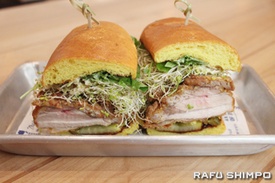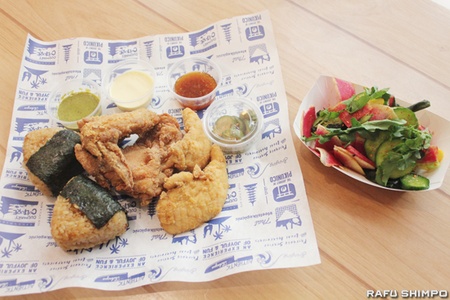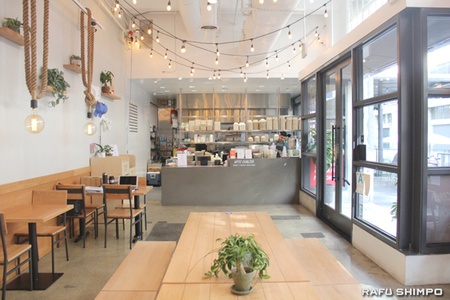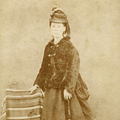"There's no way you can become a chef at 26." Her ex-husband's words ignited her fighting spirit. And she vowed to herself, "I will never give up until I can call myself a chef." "Pikunico," a fried chicken specialty restaurant, opened in December last year at RAW DTLA, a complex in downtown Los Angeles. Its owner, Hisako Yagi, was a former banker in Japan. Having never cooked before, she was led to a good encounter in America, where she trained at a famous restaurant, and opened her own restaurant. We spoke to Yagi, one of the women working hard in LA, about her commitment to the menu and the process leading up to opening her restaurant.
* * * * *
At the end of 2012, Yagi opened Hinoki and the Bird, a modern Californian restaurant in Century City, together with famous chef David Meyer, where he attracted attention for his dishes that incorporated Japanese flavors.
However, when Meyer retired due to differences in policy with his business partner, Yagi followed suit and left the restaurant after 2014.
Four years later, he found a new business partner and opened Picnico on December 3, 2018. His goal was not to create a high-end restaurant, but a restaurant that people could visit once a week. It began with the desire to provide high-quality food at an affordable price.
"When I was thinking about what kind of restaurant I should open, I remembered the fried chicken restaurant my grandmother used to take me to when I was little, and the fried chicken that the children of regular customers who came every week when I was at Hinoki would always order. Fried chicken is easy to eat and many people don't want to make fried food at home. So I thought, 'If that's the case, I can just make it myself.'"
For Yagi-san, who placed importance on a customer-oriented location, ROW DTLA, where he currently has a store, is equipped with the second largest parking lot in California after Disneyland. He liked the fact that visitors would not have to worry about parking and that he could provide validation.
The customer base is not only Japanese, but also many local Americans, so the menu is also well thought out. In addition to a set of fried chicken and fingerling fries or rice balls, fried chicken sandwiches are also available. "It's not Japanese fried chicken, but a hybrid of American and Japanese fried chicken," he says.
He also incorporated plenty of Japanese elements into sandwiches, which are a favorite of Americans. The bread is spread with his homemade "miso jam" made from a paste of miso and honey, and the jalapeños are pickled in soy sauce. Fried chicken and plenty of vegetables unique to California are added to the mix.

Deep-fried foods take a long time to digest, so ginger and turmeric are used to aid digestion. Turmeric powder is kneaded into the specially ordered bread, giving it its yellow color. Even the rice balls contain grated ginger, garlic, and olive oil, giving them a rich, flavorful taste.
The fried chicken is fried in 100% rice oil. "Using rice oil makes it less greasy and leaves a good aftertaste. I wanted it to be something you could eat rice on the same day," says Yagi. The crispy fried chicken is gluten-free. The inside is juicy, and the more you eat it, the more the essence of Japan spreads in your mouth.
The three types of salads include the classic coleslaw and potato salad, with a Japanese twist, and a cucumber salad has also been added to the menu.
The dressing is made using rice vinegar and sesame oil, and is made creamy by using sesame paste instead of mayonnaise.
He named it Picnico by combining the word "picnic" and his own name, "Kunico," because he wanted people to come and eat this food feeling like they were on a picnic.
"I have fond memories of my beloved grandmother buying fried chicken from the deli on the weekends. Just like my grandmother who gave me unconditional love, I want to make someone happy through my cooking. I want to make this a restaurant that people will want to come back to with their family," Yagi said with emphasis.
A former banker in Japan with no cooking experience, he was promoted to head chef at a famous restaurant in LA
Yagi, who has been living in the United States for 16 years, was a banker in Japan. She moved to the United States to marry her American husband, but they separated a year later due to cultural differences and the language barrier. She was unable to return to Japan because she had married despite opposition from those around her.
At the time, Yagi couldn't drive a car, so she immediately started looking for work on her beach bike. She found work as a waiter at a Japanese restaurant, but a sudden feeling of anxiety crossed her mind. "I can get by on tips now, but what will happen when I'm 40?" She hadn't found anything that made her think, "This is it!"
"Even when I was a banker, I spent a lot of time memorizing the bank's manuals and everyone worked hard to pass exams and get promoted. But even when I passed the exams and became a senior employee, I didn't feel like it was beneficial to me. If you said anything creative, people would frown on you, and it was a world where you were not allowed to do anything other than what you had been following in the bank's manuals for years. That kind of environment just didn't suit me."
Just as she was going through life without any passion, just like her time as a banker, a kitchen caught her eye. "If you can cook delicious food, you can find work anywhere in the world. What's more, chefs are required to have creative ideas. That's when the idea of becoming a chef struck me." However, she didn't have the money to go to culinary school. Yagi went to a bookstore and bought a copy of the restaurant rating book "Zagat," decided on a restaurant where she wanted to train, and came up with a plan to approach directly through the back entrance. Her destination was the high-end modern French restaurant "SONA" (now closed). A regular customer from the restaurant where she used to work as a waitress emerged from inside, and it was none other than David Meyer, the owner and chef of SONA.
After much negotiation, he was given a one-week trial. "That week was my Disneyland time." The moment he entered the kitchen for the first time, he thought, "This is it!" And one week later, he was hired.
After that, everything I saw was new to me. Everyone working in the kitchen was putting their life on the line for their job. It was a highly competitive restaurant, but after work we all went out for beers and made lively friends who talked about chefs and current food trends.
While it was fun, once I entered the kitchen, it was a struggle. If you weren't better than the others, you weren't allowed to touch the meat or fish. But even in the midst of the competition, we helped each other out like brothers, and there was a sense of camaraderie among those who loved cooking. It was a comfortable place.
"At the time, I was working for $7.50 minimum wage, but I was happy to be able to learn at the forefront of the LA culinary world while receiving a salary," said Yagi. He trained at SONA for eight years and was eventually promoted to head chef. After the restaurant closed, he expanded his field of activity, including working on the TV show "Top Chef," and trained at Michelin-starred restaurants in Japan and France. He was invited by Meyer to put all of his experience into it, and the two started "Hinoki and the Bird."
Yagi entered the kitchen without even knowing how to hold a knife, but even when things got tough and he wanted to quit, what kept him going were the words of his mentor, Meyer: "Don't give up."
"After my divorce, I decided that I wanted to be able to live on my own, rather than relying on others. I was able to continue because bad things happened. If all I had were happy things, I don't think I would have accomplished anything," she recalls.
"America helps your dreams grow. It taught me that it's okay to start anytime and to have dreams anytime. In Japan, I wasn't even allowed to wish for such things. My masters have taught me so much more than just fried chicken. It's unimaginable from the person I was 20 years ago, but I think I was able to become a chef because I was determined to become one." The environment and encounters in America helped one Japanese woman to soar.
* * * * *
Pikunico
767 S. Alameda St. Suite 122, Los Angeles, CA
Phone: 213.278.0407
Opening hours: 11am to 6pm daily Parking: 2 hours free (restaurant validation required)
*This article is reprinted from The Rafu Shimpo (May 9, 2019).
© 2019 Rafu Shimpo / Junko Yoshida








